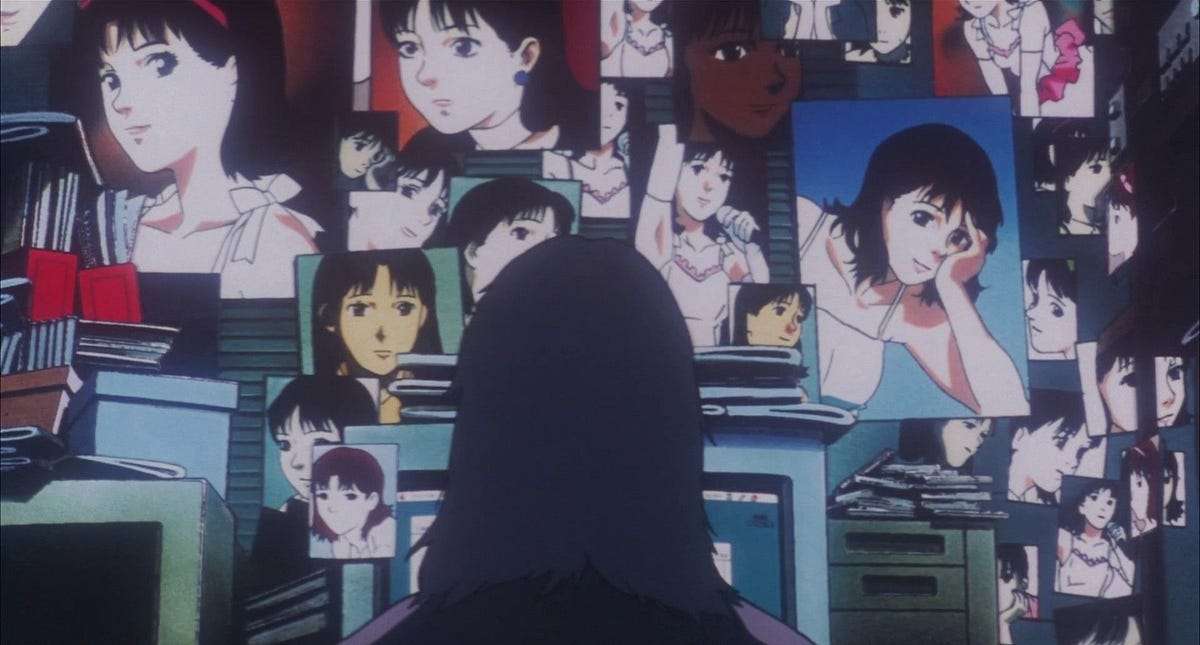“I started to wonder what unimaginable catastrophe would come about if their passions became as sharply pointed as the T-1000’s blade arm in Terminator 2, aimed at the subjects of their obsessions.”
In the Afterword to his “Perfect Blue: Complete Metamorphosis,” Yoshikazu Takeuchi reflects on how the seeds of the basic motif for the novel were planted in him during his school days. During his school days, as with people of this age, he observed his fellow mates sharing an intense passion for their varied objects of interest. This was a seedbed for the plot of his novel—the encounter between an idol and an extreme fanatic. In 1997, Satoshi Kon limned the story for the screen.
Satoshi Kon’s first feature as a director, “Perfect Blue,” recently turned 27. “Perfect Blue” is a mediation between the constant exchange between the real world with lived experience and the virtual experience of the internet that impacts the human psyche. It has Mima, a former pop idol, at the center. Mima’s life changes for the worse when she renounces her pop idol image and proceeds towards her career as an actor.
This article will answer what happens to Mima and explore some of the film’s overarching themes.
Perfect Blue (1997) Plot Summary & Movie Synopsis:
Mima Kirigoe is a pop singer of an amateur J-pop group, CHAM! However, she is soon to leave CHAM! to pursue a character in acting. At her farewell concert, a scuffle breaks out between unruly fans and an obsessive Mima fan. The sudden change of course in Mima’s career does not go well with her fans, and she soon starts receiving hostile fan emails and calls. Her agent, Mr. Tadokoro, and her manager, Rumi, who was once a pop star, support the transition.
Mima lands a small role in a television detective procedural drama called Double Bind. Tadokoro On her first day of the shoot, Mima receives fan mail, which Mr. Tadokoro opens. The mail, containing an explosive, explodes and severely injures Tadokoro. Mima is concerned, but Rumi shoves it off as a prank. The letter instructs Mima to visit a website named ‘Mima’s Room,’ an online fan-made diary of sorts purporting to record all of Mima’s routine and experiences.
The website, to Mima’s surprise, has details that are extremely personal and, hence, abnormal to be found on a fan website. Mima’s stalker is seen lurking around. Once at the elevator, Mima finds a news report stating the critical condition following a hit-and-run of one of the unruly fans. When she spots the stalker before the elevator leaves, it is hinted that it is the stalker’s doing, and he has carefully placed the newspaper report to invite Mima’s attention.
The beginning of Mima’s acting career is uneventful. Tadokoro, however, manages to talk to the creators, and they conjure up a highly scandalous role, which is to change Mima’s image forever. Mima’s character is about to experience a complete change in personality when she is raped by the customers at a local strip club. Rumi is averse to the idea, but Mima obliges. Mima’s discomfort and anxiety surrounding the choice is visible as she tries to over-explain her decision. While going back home, Mima sees her reflection being overlapped by the image of her former pop idol self, asserting: “ I refuse to do it.” Mima puts up a calm front when out and about in the world, but acting in the rape scene leaves her mentally and emotionally distraught. Meanwhile, her former pop idol self keeps reappearing as ephemeral sightings, claiming to be “the real Mima.”
Mima becomes increasingly concerned over the frequent reminders of the presence of the unknown stalker in Mima’s room. What also remains a sore spot is the success of CHAM! sans Mima. Soon, the scriptwriter of Double Bind is found dead with his eyes and torso severely stabbed. The obsessive stalker is revealed as Mr. Me-Mania, who has taken it upon himself to preserve the old image of the pop idol days of Mima. Me-Mania hallucinates ‘the real Mima’ pleading with him to help her get rid of the imposter Mima– the one who has been unfaithful to her pop idol image due to her foray into acting and has increasingly devoted herself to the making of an adult star. At this juncture, Mima, being unable to control the mutation of the real and the imaginary, develops psychosis.
The imaginary Mima keeps appearing and reappearing, tormenting the real Mima. She keeps reminding Mima of her former life, her inability to return to the same, and the betrayal that she is continuously acting out towards herself and her admirers. Mima finds herself living and reliving the same scenarios, which makes her question her sanity. This time, the photographer who had Mima’s nude photographs gets killed in a manner akin to the murder of the scriptwriter. All evidence points to Mima’s involvement in the murder. That the reality and the imaginary have become enmeshed becomes palpable when we start experiencing the confounding episodes of the Double Bind shooting and Mima’s real life overlapping, where one cannot be separated from the other.

Soon, a vengeful Me-Mania attacks Mimarin, accusing her of stealing the real Mima’s identity, too. He reveals that the real Mima, who has a pious image, sends him emails every day. As he tries to rape her, he confesses to having killed the scriptwriter and the photographer. In the end, MIma ends up hitting Me-Mania with a hammer on his head. However, Mima, along with the spectators, becomes uncertain about the truth of the event.
Perfect Blue (1997) Movie Ending Explained:
Who is the real Mima?
Mima and Rumi drive back to Mima’s apartment. Mima gives a call to Mr. Tadokoro, who is shown to be dead. Soon, it dawns on Mima that the apartment that she has been brought into, despite the familiar props, is similar to her bedroom but not at all hers. It is the bedroom of the Mima, the specter in her stage costume. This spectral Mima is, in fact, a manifestation of Rumi’s madness. It is Rumi’s madness that has spilled over to Mima’s psyche. We get to know that Me-Mania was simply instructed by Rumi. Rumi injures Mima with an ice pick, the same ice pick that was instrumental in the other murders. She starts chasing Mima and injures her multiple times.
The end inevitably arrives, but none of them are dead. A hallucinating Rumi comes before a moving truck, but Mima quickly saves her. Both Mima and Rumi survive. However, Rumi is now exiled in a mental institution. Mima comes regularly to check on her. When Mima leaves, she overhears two nurses noticing her but dismissing her as just a look-alike of the real Mima. The film ends with Mima smilingly proclaiming: “I’m the real thing.”
Perfect Blue (1997) Movie Themes Analysed:
Fame and Loneliness
In a letter dating back to 1922, Einstein, while reflecting on the mercurial nature of fame, writes:
“Worshipped today, scorned or even crucified tomorrow, that is the fate of people whom — God knows why — the bored public has taken possession of.”
Perhaps no other description of fame fits Mima so perfectly than this. Mima’s identity is actually a possession of the desires of her fans, albeit not always the benevolent worshippers. It does not take much for the fans to disparagingly call her a traitor when she falters at their expectation. Me-Mania, who fights against unruly fans to protect and preserve Mima’s sanctity in the beginning, eventually emerges as her biggest source of terror.
Apart from the few moments of grocery shopping, we rarely see Mima indulge in activities that are beneficial for her own well-being. Barring herself, everyone surrounding her seems to own her identity in some form and fashion it according to their own desires. Ironically, her thankfulness, and perhaps enfeeblement, to the fame she has achieved also drives her to do what she ends up doing. The fame that has made Mima so attainable to the people ironically also isolates her.
Interestingly, Hannah Arendt’s 1951 mediation, which correlates loneliness as a keystone of personal and political experience, reflects that real terror is when people lose contact not only with their fellow humans but also with the reality that surrounds them. Arendt, albeit expounding on tyrannical regimes, continues, “Terror can rule absolutely only over men who are isolated against each other…Isolation may be the beginning of terror; it certainly is its most fertile ground; it always is its result”. Mima’s experience of terror and isolation is akin to what Arendt states.
Mima’s celebrity life makes her increasingly detached from the people and herself and at the receiving end of persistent fixation. The new career disconnects her from interacting with her audience; her legion of fans slowly starts turning caustic as they see Mima shedding her previous persona, which makes her more acceptable and revered. With the outside world turning hostile towards her every passing day, she slowly succumbs to the loneliness, which eventually makes her incapable of discerning reality. This is precisely the terror that engulfs and, perhaps more accurately, savages Mima.
Madness

Madness permeates and informs the very form and structure of the narrative in “Perfect Blue.” While the film does not explicitly provide a testament to Mima’s madness, Mima’s sedative point-of-view, which disorients the spectator, is actually Mima’s lived experience, which is equally disorienting. Mima’s constant interaction with her former self might be the overture to what is to come. Just as disorienting is the constant imbrication of the real and the imagined.
Mima wakes up twice in her bedroom to a TV report announcing the ‘New Citizen’s Life Index.’ The first time, while expressing her concerns to Rumi over the possibility of the other self behaving erratically or autonomously, Mima starts living parallelly on the shoot of Double Bind, where a similar tragedy unfolds pertaining to illusion and reality. We do not know the means to identify and separate Mima’s real life from the plot of the series she is acting in– was Mima at the shoot all along and had been hallucinating about having the conversation with Rumi, or did the shoot never happening and she is still in her room?
The viewer is always kept in a state of ambiguity; that is, there is uncertainty about whether what they are presented with is related to the narrative of the film “Perfect Blue” or from the film within the film, that is, Double Bind. There is also a moment where Mima within Double Bind is suddenly referred to as Mima. However, one wonders if that is too a hallucinatory memory. The sudden eruption of scenes from Double Bind within the flowing narrative of “Perfect Blue” is an editing choice that corresponds to the mental state of Mima.
The Internet
Satoshi Kon foregrounds the internet as a conduit between the virtual space populated and patrolled by the fans and the interior space– not only restricted to the physical space but, by extension, the psyche–- of the object of obsession, here Mima. The name of the website, ‘Mima’s Room,’ is almost a double entendre, an allusion towards the presence of a menacing underbelly. When she finds a note, an inexperienced Mima asks Rumi about the function of the website called ‘Mima’s Room.’ Rumi explains that the sender has created a webpage, a fledgling virtual specimen then, on the Internet by the name Mima’s Room.
The link to the website of ‘Mima’s Room’ is a tentacled link to the physical and psychological inner chambers of Mima. The obsessive stalker, Me-Mania, creates ‘Mima’s Room,’ writes the entries pretending to be the ‘real’ Mima, and puts out details that are almost incriminating in nature. The virtual Mima starts to threaten the identity and sanity of the real Mima.
What does the color blue signify in Perfect Blue?
The film retains the title that it draws from its source material, the novel “Perfect Blue: Complete Metamorphosis” by Yoshikazu Takeuchi. Although there has been no set-in-stone explanation behind the choice of the title, some attempts can be made to grasp the essence of such a choice. Popularly, blue is the color of melancholy. But “Perfect Blue” is no film of easy melancholy– a kind of universal and necessary human experience. It is a film of extraordinary terror of the degradation of the human mind. Blue has been observed as the most frequent color preference among patients with psychiatric disorders.
The poster of “Perfect Blue,” in which Mima can be found lying in a heap of her personal belongings and gazing blankly into the unknown, is predominantly saturated with blue. We see Mima lying on top of her personal belongings that we might have seen in her coquette bedroom. However, the area has started vegetating, causing her personal effects and Mima herself to decompose.
Here, it is Mima’s mental equilibrium that has started to decay. Although one would expect earthy color tones given the visual elements present in it, the drawback of such a color tone is that it merely reduces the entire picture to bodily decomposition. The limning of the entire frame with blue underscores and foregrounds the psychological connotation of the decomposing subject.
Read More: The 25 Best Animated Movies of All Time
Trailer:
Perfect Blue (1997) Movie Links: IMDb, Rotten Tomatoes, Wikipedia, Letterboxd
Cast: Junko Iwao, Rica Matsumoto, Shiho Niiyama, Masaaki Okura, Shinpachi Tsuji, Emiko Furukawa
Genre: Mystery & Thriller/Anime | Runtime: 1 hr. 20 min.



![Wind River [2017]: Horrors of a Forgotten Community](https://www.highonfilms.com/wp-content/uploads/2017/10/7456-768x413.jpg)


![Stuff and Dough [2001] Review – Fresh Oppurtunities, Same Dead-Ends](https://www.highonfilms.com/wp-content/uploads/2020/11/Stuff-and-Dough-2001-768x432.jpg)

